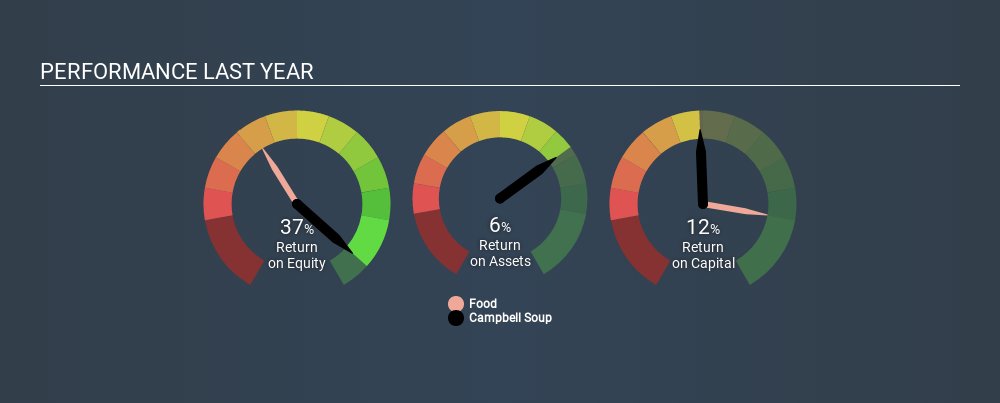- United States
- /
- Food
- /
- NasdaqGS:CPB
Campbell Soup Company (NYSE:CPB) Earns A Nice Return On Capital Employed

Today we'll evaluate Campbell Soup Company (NYSE:CPB) to determine whether it could have potential as an investment idea. In particular, we'll consider its Return On Capital Employed (ROCE), as that can give us insight into how profitably the company is able to employ capital in its business.
First up, we'll look at what ROCE is and how we calculate it. Then we'll compare its ROCE to similar companies. Finally, we'll look at how its current liabilities affect its ROCE.
Return On Capital Employed (ROCE): What is it?
ROCE is a measure of a company's yearly pre-tax profit (its return), relative to the capital employed in the business. In general, businesses with a higher ROCE are usually better quality. Ultimately, it is a useful but imperfect metric. Author Edwin Whiting says to be careful when comparing the ROCE of different businesses, since 'No two businesses are exactly alike.
How Do You Calculate Return On Capital Employed?
The formula for calculating the return on capital employed is:
Return on Capital Employed = Earnings Before Interest and Tax (EBIT) ÷ (Total Assets - Current Liabilities)
Or for Campbell Soup:
0.12 = US$1.1b ÷ (US$13b - US$3.4b) (Based on the trailing twelve months to October 2019.)
So, Campbell Soup has an ROCE of 12%.
See our latest analysis for Campbell Soup
Does Campbell Soup Have A Good ROCE?
When making comparisons between similar businesses, investors may find ROCE useful. Campbell Soup's ROCE appears to be substantially greater than the 9.2% average in the Food industry. I think that's good to see, since it implies the company is better than other companies at making the most of its capital. Separate from Campbell Soup's performance relative to its industry, its ROCE in absolute terms looks satisfactory, and it may be worth researching in more depth.
We can see that, Campbell Soup currently has an ROCE of 12%, less than the 24% it reported 3 years ago. So investors might consider if it has had issues recently. The image below shows how Campbell Soup's ROCE compares to its industry, and you can click it to see more detail on its past growth.

It is important to remember that ROCE shows past performance, and is not necessarily predictive. ROCE can be misleading for companies in cyclical industries, with returns looking impressive during the boom times, but very weak during the busts. ROCE is, after all, simply a snap shot of a single year. Since the future is so important for investors, you should check out our free report on analyst forecasts for Campbell Soup.
How Campbell Soup's Current Liabilities Impact Its ROCE
Current liabilities are short term bills and invoices that need to be paid in 12 months or less. The ROCE equation subtracts current liabilities from capital employed, so a company with a lot of current liabilities appears to have less capital employed, and a higher ROCE than otherwise. To counter this, investors can check if a company has high current liabilities relative to total assets.
Campbell Soup has total liabilities of US$3.4b and total assets of US$13b. Therefore its current liabilities are equivalent to approximately 26% of its total assets. Current liabilities are minimal, limiting the impact on ROCE.
What We Can Learn From Campbell Soup's ROCE
Overall, Campbell Soup has a decent ROCE and could be worthy of further research. There might be better investments than Campbell Soup out there, but you will have to work hard to find them . These promising businesses with rapidly growing earnings might be right up your alley.
If you are like me, then you will not want to miss this free list of growing companies that insiders are buying.
If you spot an error that warrants correction, please contact the editor at editorial-team@simplywallst.com. This article by Simply Wall St is general in nature. It does not constitute a recommendation to buy or sell any stock, and does not take account of your objectives, or your financial situation. Simply Wall St has no position in the stocks mentioned.
We aim to bring you long-term focused research analysis driven by fundamental data. Note that our analysis may not factor in the latest price-sensitive company announcements or qualitative material. Thank you for reading.
About NasdaqGS:CPB
Campbell's
Manufactures and markets food and beverage products in the United States and internationally.
Established dividend payer slight.
Similar Companies
Market Insights
Community Narratives





